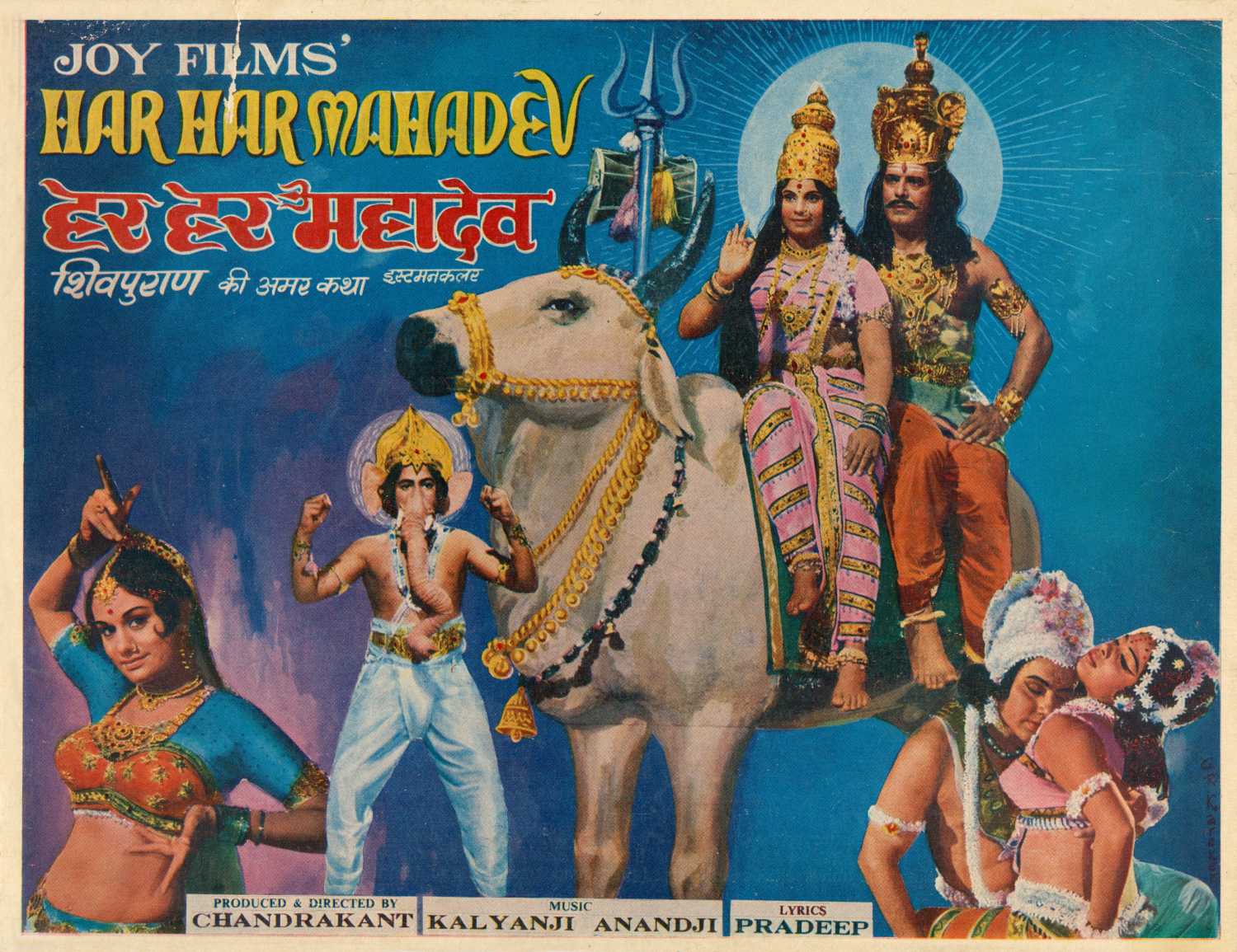 Hindi Devotional movie madness doesn’t get much madder than this 1974 epic. Directed by Chandrakant, a veteran of Devotional cinema, this film seeks to dramatize the entirety of the multi-volume Sanskrit text SHIVA PURANA. This means that, whatever shortcomings HAR HAR MAHADEV might have, a lack of ambition isn’t one of them.
Hindi Devotional movie madness doesn’t get much madder than this 1974 epic. Directed by Chandrakant, a veteran of Devotional cinema, this film seeks to dramatize the entirety of the multi-volume Sanskrit text SHIVA PURANA. This means that, whatever shortcomings HAR HAR MAHADEV might have, a lack of ambition isn’t one of them.
The subject is Lord Shiva, the Lord of the Universe who carries an imposing trident and wears a live cobra draped around his neck. Together with the multi-headed Brahma and the four-armed Vishnu, Shiva completes the Trimurti, or Hindu trinity.
The film opens with Shiva marrying Sati, the daughter of King Daksha. Daksha wants nothing to do with Shiva, inspiring Sati to commit suicide by jumping into a fire pit (because “The honor of a woman lies in her husband. He’s her god. Sati killed herself to prove this point to all women”). Upon hearing of this Shiva conjures up an avatar named Mahadev to behead Daksha, but after doing so Mahadev has a change of heart and brings Daksha back to life, albeit with a goat’s head.
Sati is reincarnated as Parvati, daughter of the mountain king Himavan. Shiva, after securing permission from the king, marries Parvati in a lavish ceremony with everyone who’s anyone in attendance. But trouble lurks in the form of the Demon King Tarkasur, who, it’s been prophesied, will be killed by the son of Shiva—hence, Tarkasur demands that his minions keep watch over Shiva and Parvati and, when the child is born, kill him.
The birth, however, goes off without incident. The result is Kartikeya, a five-headed brat who can shoot fire at his enemies—and does to so ward off Tarkasur’s minions. At the behest of his elders Kartikeya rides a flying peacock through the air to Tarkasur’s palace and, following a massive fight, casts Tarkasur into the sea.
Shiva’s other son Ganesh is impertinent to his father. Eventually Shiva gets fed up with Ganesh’s obstinacy and beheads him with his trident, which upsets Parvati greatly. She retaliates by threatening to destroy the world, inspiring Shiva to bring Ganesh back to life, but with an elephant’s head (actually a boy with an elephant snout). This has the effect of curbing Ganesh’s wonton ways, and, after he bests an opponent by strangling him with his trunk, the boy is branded the “Savior of the universe.”
Ganesh and Kartikeya have a contest decreeing that the first of them to run around the earth will get married. Ganesh does this by simply walking around his parents, reasoning that, since Parvati represents the earth and Shiva the heavens, this counts. Thus Ganesh gets married to the sisters Siddhi and Buddhi, much to Kartikeya’s dissatisfaction.
But Tarkasur is stull afoot, and up to no good. He lures Ganesh into a trap and imprisons him in a dungeon, incurring the wrath of Shiva, who frees Ganesh and burns down Tarkasur’s kingdom. There’s also the half-buffalo demon Mahishasur, who attempts to take over the heavens. To combat Mahishasur the Trimurti create the multi-limbed Goddess Kali, leading to a vast war in which Kali bests Mahishasur.
Further strife occurs in the form of the arrogant goddess Ganga, who Shiva entangles in his hair, and inspires to turn over a new leaf. There’s also a boy who wants milk his impoverished mother can’t provide, leading Shiva and Parvati to provide the woman with a cow, and Ravana, a demon who after being granted supernatural powers by Shiva attempts to use them to usurp him—an attempt that, as you might guess, doesn’t go down too well—and the creation of half-monkey Hanuman, Mahadev’s 11th avatar, who becomes the God of Wisdom.
The above, believe it or not, is an extremely condensed summary of this film’s overflowing narrative. Cramming it into a lengthy-but-not-lengthy-enough 160 minute runtime results in a great deal of incoherency; there’s so much exposition to get through it takes a full thirty minutes for the first musical number to occur (music numbers being requisites in old-timey Hindi cinema). The film is by necessity extremely fast paced, with a narrative that grows increasingly fragmented and episodic as it advances. Much is left unexplained (how is it that toward the end Ganesh somehow grows four extra heads?) and the conclusion is plain ridiculous, depicting what is perhaps the silliest fight ever, between two guys on a beach who swing fake-looking bludgeons at each other.
The production design is marked by pristine white palaces and painted sky backdrops that are intercut, clumsily, with stagey earthbound scenery, and the quality of the special effects is just as you’d expect—meaning hilariously awful. All those things, of course, are common to Hindi Devotional Cinema (as is an image you’ll find here and in quite a few other such films, of two arrows shot at each other and colliding in mid-air), in whose ranks HAR HAR MAHADEV is above average.
Silly though it all is, the film is quite watchable. The images have a sleek, professional sheen, and the film has been better preserved than most pre-1990 Hindu cinema (with no fading or scratches that I could see). The songs, at least in comparison to those of most Indian films, aren’t even bad (sample lyric: “Shiva-Shiva-Shum, O bum, bum, bum”). This means that for anyone with an interest in Hindi Devotional Cinema HAR HAR MAHADEV is an excellent starting point.
Vital Statistics
HAR HAR MAHADEV (HAIL LORD SHIVA)
Joy Films
Director/Producer: Chandrakant
Cast: Dara Singh, Jayshree Gadkar, Shahu Modak, Padma Khanna, Abhi Bhattacharya, Aruna Irani, Jagdish Raj, Gopi Krishna, Uma Bhende, Sumitra Devi, V. Gopal, Polson, Babu Raje, Randhawa, Raj Rani, Ratnamala, Satyajeet, Asit Sen, Sujata
